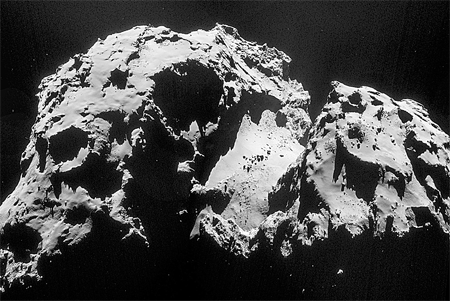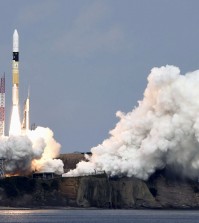- California Assembly OKs highest minimum wage in nation
- S. Korea unveils first graphic cigarette warnings
- US joins with South Korea, Japan in bid to deter North Korea
- LPGA golfer Chun In-gee finally back in action
- S. Korea won’t be top seed in final World Cup qualification round
- US men’s soccer misses 2nd straight Olympics
- US back on track in qualifying with 4-0 win over Guatemala
- High-intensity workout injuries spawn cottage industry
- CDC expands range of Zika mosquitoes into parts of Northeast
- Who knew? ‘The Walking Dead’ is helping families connect
The landing of Philae
The robot probe Philae was able to land on Comet 67P/Churyumov-Gerasimenkoon November 12, 2014 after traveling since 2004 with the Rosetta spacecraft. The lander awkwardly bounced two times before it could land the third time, with the first rebound lasting two hours and the second lasting seven minutes. The several rebounds were a result of the cold gas system failing to work. In addition, there were two major drawbacks for Philae to overcome before it could accomplish the key goal of the mission, which was to use the lander’s drill to obtain material from beneath the surface of the comet.
The first drawback was that Philae landed on two legs instead of the envisioned three, making its positioning askew and its stabilityweak. The odd position, scientists say, may be the result of Philae landing on the rim of comet’s crater. The lander will need to use its drill in order to collect sub-surface material from the comet, but the force of the drill could send Philae off of its balance because it is not secured to the comet by a harpoon. This is why the scientists are finding other alternative strategies.
The second drawback is the battery life of Philae.
There is not enough light hitting Philae because it receives only one and a half hours of light during the comet’s twelve hour rotation. Without light on its solar panels, the lander’s battery life is around sixty hours. Time is of the essence, as the battery does have an expiration date.
Regardless, the landing of Philae is the first time in history for scientists to successfully soft land a probe onto a moving comet, which will lead to a further increase of our understanding of these icy rock giants. Before, scientists could only observe from a distance. The probe will also be the first to take images of a comet’s surface, as well as the first to do on-site analysis of a comet’s composition. This milestone is bound to make a mark in the field of science.
 |
Michelle Xu Arnold O. Beckman High School 11th |















Michael Miller
December 3, 2014 at 11:56 AM
Michelle,
While I am excited like you about the Rosetta project, don’t forget about the success of the JAXA Hayabusa1 project that left earth in 2003 and returned in 2010 with samples collected from an asteroid. Hayabusa2 blasted off last night on the next JAXA mission to investigate asteroids. Pretty spectacular. NASA and especially the U.S. Congress should be ashamed of what has happened to our space program.
Keep up your interest in science!
Best regards.
kelly
November 27, 2017 at 2:07 PM
yes..I like the basic concepts behind Second Life but it seems incredibly outdated and when I played it was intensely non-intuitive / user friendly to an extent that made EVE look like a game for toddlers. thanks from
togel online